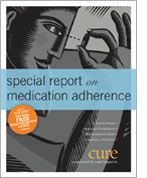Publication
Article
CURE
Need a Reminder to Take Your Medicine?
Author(s):
Different strategies for medication compliance are needed for different patients.
Different strategies for different patients—that’s the way it rolls in the world of oral chemotherapy. If patients find electronic or paper reminders helpful, here are some resources to consider.
Applications (apps): Paul Cerrato, editor of InformationWeek Healthcare, recommends a pair of apps for pill reminders. Pillboxie (99 cents at iTunes) lets patients program the time of day for an iPhone or iPad reminder. They can select an icon that’s the shape and color of the pill (say, green and round) and type in the dosage. Cerrato also likes RxmindMe, a free app at iTunes. Patients can take a photo of the pill, plug in dosages, the doctor’s name and other prescription information. See rxmind.me for a rundown of features.
Email or text reminders: An online calendar linked to an email account or able to text cellphones can send patients pop-up messages and/or email reminders. All patients have to do is enter information about the pill at the scheduled time of day when they’ll take it. When using electronic reminder systems, however, patients should be aware of a condition that the medical community calls “alert fatigue.” If patients are receiving 10 or 15 daily reminders popping up on their cellphones or computers, they may end up ignoring them.
Paper: Patients don’t have to buy a special calendar for pill reminders—a regular workhorse calendar hanging in the kitchen will do just fine. Patients can also check with the pharmacy or doctor’s office—they may have a calendar tailored for pill-taking with space for recording side effects. The Dana-Farber Cancer Institute offers downloadable pill diaries for once-a-day, twice-a-day, or multiple oral chemotherapies. Patients fill in the time they take the pill and the dosage, and there’s a box where they can track side effects as well. See: dana-farber.org/Health-Library/Oral-Chemotherapy-Drug-Diary.aspx.






